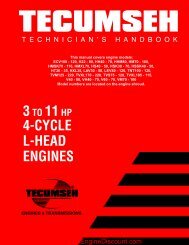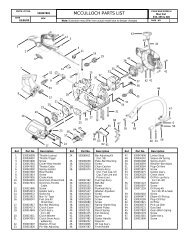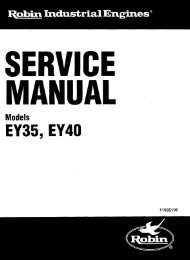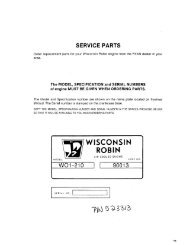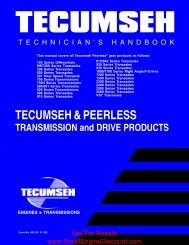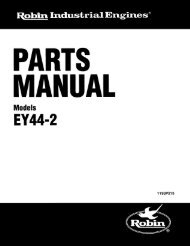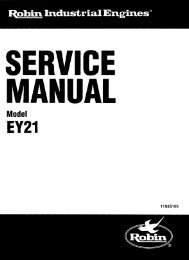EY15V, EY20V - Small Engine Discount
EY15V, EY20V - Small Engine Discount
EY15V, EY20V - Small Engine Discount
Create successful ePaper yourself
Turn your PDF publications into a flip-book with our unique Google optimized e-Paper software.
IO. ROBIN SOLID STATE IGNITION ENGINE<br />
10-1 FEATURES<br />
Model EY 15V can employ as option a pointless igniton system, called Solid State Ignition, which is the circuit<br />
breaker type ignition device, utilizing the power transistor as an element for controling electric current.<br />
.This system is outer coil type without pulser and is called T.I.C. (Transistor ignition circuit type). To the<br />
<strong>EY20V</strong> this T,I.C. is equipped as standard parts.<br />
Being different from the breaker point type ignition system, this brand-new system is completely free from<br />
such troubles as starting-up failure owing to dirty, burnt or oxidized point surface, lowering of igntion efficiency<br />
being caused by moisture, rough surface of breaker point and incorrect timing resultant from worn<br />
mechanical parts.<br />
10-2 BASIC THEORY of T.I.C. (See Fig. 52.)<br />
1 T.I.C. (Transistor igntion type) consists of the flywheel<br />
and ignition coil with built-in transistor; and<br />
its basic theory is as follows:<br />
1) Revolution of the flywheel generates electricity<br />
4d<br />
on the primary side of the ignition coil, and the .;<br />
electric current A runs. A makes the power tran- K<br />
sistor “ON” and the electric current B passes.<br />
2) The flywheel goes round further, and at the time 5<br />
of ignition the electric current C runs, then the<br />
v)<br />
.g<br />
electric current D runs to the signal transistor, cc<br />
by which the electric current B, passing through<br />
the power transistor, is abruptly cut; and as a<br />
result, the high voltage electricity is generated<br />
on the secondary side of the ignition coil and it<br />
sparks at the plug.<br />
Resister<br />
Ignition Coil<br />
m 0)<br />
3<br />
Fig. 52<br />
-<br />
a<br />
2<br />
a<br />
m<br />
v,<br />
- 37 -




